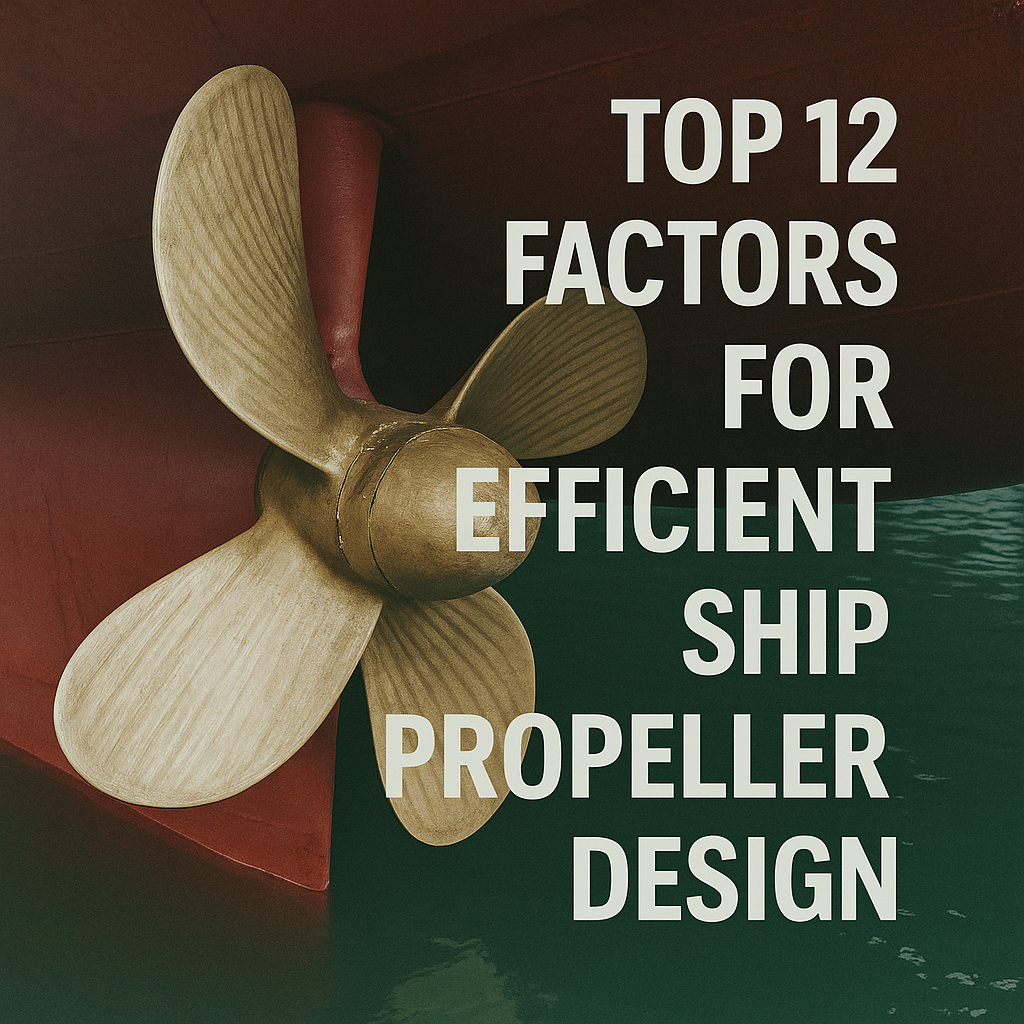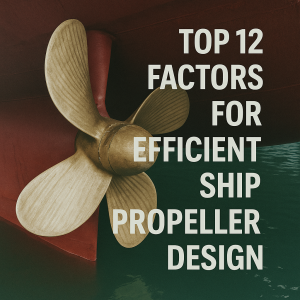Discover 12 critical factors for designing efficient ship propellers that can transform fuel savings, performance, and environmental impact. A must-read guide for maritime engineers and enthusiasts.
Why Propeller Design Really Matters
Imagine a cargo ship sailing across the Atlantic. Its gigantic propeller, spinning below the waterline, silently pushes thousands of tonnes through heavy seas. Yet that huge propeller is a masterpiece of science and engineering — where a small mistake in the blade angle or diameter can mean millions lost in fuel, delays in delivery, or even safety hazards. Propellers are more than a piece of metal; they are the true workhorses of ship propulsion, converting engine power into forward thrust. With fuel costs eating up nearly 40–60% of operating expenses (source: Marine Insight, 2023), an efficient propeller design is vital for sustainable and profitable shipping.
In this guide, we will explore 12 key factors that marine engineers, naval architects, and ship operators must consider when designing or evaluating ship propellers — and why getting them right can spell the difference between smooth sailing and a costly disaster.
Why Efficient Propeller Design Matters in Modern Marine Operations
Modern shipping is under unprecedented pressure:
- Emission regulations from IMO (like EEXI and CII under MARPOL Annex VI)
- Fuel price volatility
- Higher demands for on-time delivery
- Competition in global markets
An inefficient propeller does more than burn excess fuel. It increases carbon emissions, adds stress to the propulsion train, and can even harm marine life through excessive cavitation noise. Lloyd’s Register has reported that propeller design alone can influence fuel consumption by as much as 15% on some vessels (Lloyd’s Register, 2022). In an era of decarbonisation and green shipping, propeller efficiency is truly a frontline issue.
Key Technologies Driving Change
In the last five years, there have been remarkable advances in propeller design technologies:
- CFD (Computational Fluid Dynamics) modelling for real-time performance predictions
- Additive manufacturing (3D printing) for custom blade prototypes
- New biomimetic shapes inspired by fish fins or whale flukes
- Surface coatings that reduce fouling and improve flow
- Integrated energy-saving devices (like hub caps and ducted propellers)
These innovations help designers squeeze every bit of thrust from fuel while minimising vibration, noise, and emissions.
In-Depth Analysis: 12 Factors for Efficient Ship Propeller Design
Let’s dive into what really matters.
Blade Number and Shape
One of the most critical decisions is the number of blades. Fewer blades generally mean higher efficiency due to lower drag, but more blades can reduce vibrations and improve load-carrying.
For example, tankers usually run with 4-bladed propellers for robustness, while fast ferries might use 5–6 blades to reduce cavitation at higher RPMs.
Beyond the count, blade shape — including its chord length, camber, and tip geometry — dramatically affects the flow. According to Principles of Naval Architecture by the SNAME society, a well-optimised blade shape can improve propeller thrust efficiency by up to 12%.
Diameter and Pitch
The diameter and pitch of the propeller determine how much water mass is moved per rotation. A large-diameter, low-pitch propeller is excellent for slow-speed, high-torque conditions (such as bulk carriers), while a smaller-diameter, higher-pitch propeller suits high-speed vessels.
It is a balancing act. Oversize the diameter and you risk grounding clearance; undersize it and you lose efficiency.
Cavitation Management
Cavitation — the formation of vapour bubbles on the suction side of the blade — is one of the biggest enemies of propeller efficiency. Apart from causing erosion, cavitation also creates noise that disturbs marine mammals.
Naval architects use software like CFD plus cavitation tunnel testing to predict and minimise cavitation pockets. For reference, IMO’s Guidelines for Underwater Radiated Noise (MEPC 2023) now encourage designs that reduce cavitation noise to protect marine life.
Wake Adaptation
The flow of water reaching the propeller, called the ship’s wake, is never uniform. A well-designed propeller must adapt to these inflows to avoid unbalanced blade loading.
Modern projects use wake-adapted propellers and energy-saving devices (ESDs) to “smooth” the wake profile and boost propulsive efficiency by 3–5%, according to DNV studies in 2023.
Propeller–Hull Interaction
Propeller efficiency depends on the hull shape. Poorly designed aft hull forms create uneven water inflows, leading to propeller vibration, noise, and fatigue.
That’s why propeller design must go hand-in-hand with hull design — they are a true partnership. Class societies like BV and ClassNK even recommend joint hull–propeller CFD studies as best practice.
Material Selection
Traditionally, propellers use nickel-aluminium bronze because of its corrosion resistance. But new alloys, including composites and even titanium blends, are emerging thanks to 3D printing and advanced metallurgy.
These materials offer lighter weight and greater damage tolerance, reducing repair costs while preserving strength.
A 2021 research paper in Ocean Engineering found composite propellers could reduce fuel consumption by 2–4% due to lower inertia and better flow profiles.
RPM and Engine Matching
A propeller can only be efficient if it is properly matched to its engine’s characteristics. Engineers must align propeller RPM with the engine’s optimal torque range.
Mismatches — a classic mistake — create slip, vibrations, and poor fuel consumption. Simulation tools today can accurately predict the best RPM range even before construction.
Tip Clearance
Tip clearance — the distance between the blade tip and the hull — is a subtle but vital design factor. Too small a clearance causes vibration and risk of blade–hull collision; too large a clearance lowers thrust.
Most classification societies advise a clearance of around 15–20% of the propeller diameter for optimal compromise.
Skew and Rake
Propeller blades are often “skewed” backward and “raked” aft to reduce pressure pulses on the hull and minimise cavitation.
This shape adjustment softens the load on each blade, improving passenger comfort on cruise ships or vibration-sensitive vessels like cable-layers.
The Royal Institution of Naval Architects suggests skew angles up to 30° and rakes up to 15° can significantly reduce underwater noise.
Surface Finish
A rough propeller surface encourages biofouling and flow turbulence. Marine engineers now pay close attention to polishing, coatings, and even antifouling paints.
Smooth propellers translate directly to lower fuel use and less underwater radiated noise — a sustainability win in line with IMO’s decarbonisation strategy.
Ice Class and Special Operating Conditions
Ships sailing Arctic or Antarctic routes need propellers tough enough to handle ice impacts. These are designed with thicker sections, more robust edges, and special alloys.
The IACS Unified Requirements for Polar Class ships specify increased material toughness and blade edge profiles to resist ice damage.
Class Rules and Regulatory Compliance
Finally, all propeller designs must comply with international standards. Class societies such as Lloyd’s Register, ABS, DNV, and Bureau Veritas have strict guidelines for propeller stress, fatigue, and vibration performance.
Ignoring these standards not only breaks the law but endangers lives.
–
Case Studies: Propeller Failures and Lessons
Consider the MSC Zoe grounding incident, where propeller damage contributed to severe vibrations and cargo loss. Investigators concluded the clearance between the blade tips and the hull was inadequate.
Another example: in 2021, a passenger ferry in Norway had to be taken out of service for weeks after cavitation erosion wrecked its blades — the propeller had been wrongly matched to a newly converted LNG engine.
Both stories highlight the stakes of getting propeller design wrong.
Challenges and Solutions in Propeller Optimisation
The challenges are real:
-
Decarbonisation means higher propulsion efficiency is no longer optional
-
Data quality from ship trials can be poor
-
Skilled propeller engineers are in short supply globally
Solutions include:
-
Investment in advanced CFD and model basins
-
Collaboration between engine makers, shipyards, and classification societies
-
Training new generations of marine engineers with blended digital and practical skills
Future Outlook: A Greener Propeller Revolution
Looking forward, expect to see:
-
More biomimetic (nature-inspired) blade designs
-
Widespread adoption of energy-saving devices (ESDs)
-
Better monitoring of propeller condition using AI and IoT sensors
-
Wider use of advanced materials like composites and titanium
The World Maritime University and IMO’s GHG Strategy both identify propeller optimisation as key to decarbonising shipping by 2050.
Frequently Asked Questions
Why does propeller diameter matter so much?
Because it controls how much water mass you push each rotation, directly affecting thrust and fuel burn.
What is cavitation and why is it bad?
It is the formation of vapour bubbles on the blade, causing erosion, noise, and performance loss.
Are composite propellers safe?
Yes, they are increasingly class-approved and show good fatigue resistance with lighter weight.
How do energy-saving devices work?
They smooth water flow into the propeller, reducing turbulence and boosting efficiency.
Do propellers have to meet class rules?
Absolutely — class societies demand strict tests on vibration, fatigue, and strength.
Can propeller shape reduce underwater noise?
Yes, skewed and raked blades significantly soften noise impacts for marine mammals.
Is bigger always better for a propeller?
Not always. Too big creates clearance issues, while too small loses efficiency. It’s about balancing design with hull, speed, and mission.
Conclusion: Your Propeller Is the Ship’s True Champion
Every tonne of cargo, every dollar of fuel, every tonne of CO2 saved — your ship’s propeller makes the difference. Propeller design is not a side job. It is core to maritime efficiency, sustainability, and safety.
If you are a marine engineering student, a ship designer, or a senior engineer, remember these 12 factors as your compass. Propellers are silent heroes — but only if designed with care, data, and creativity.
References
- International Maritime Organization
- Lloyd’s Register
- Royal Institution of Naval Architects
- Marine Pollution Bulletin
- DNV
- Ocean Engineering
- Marine Insight
- Paris MoU
- WMU Journal of Maritime Affairs
- Britannica, Ship Propeller (2023 Edition)


